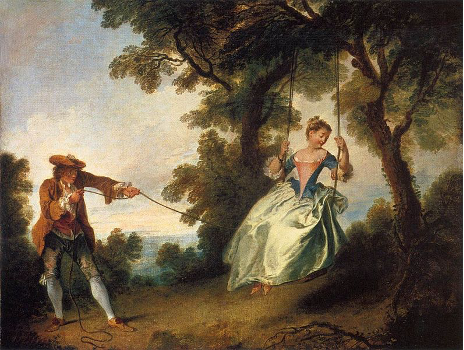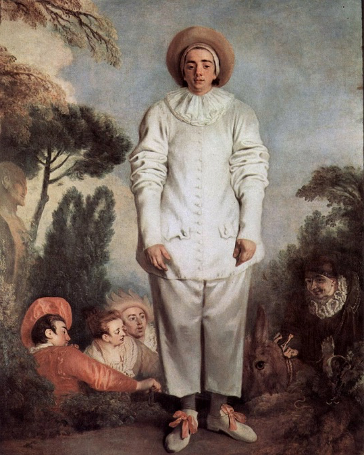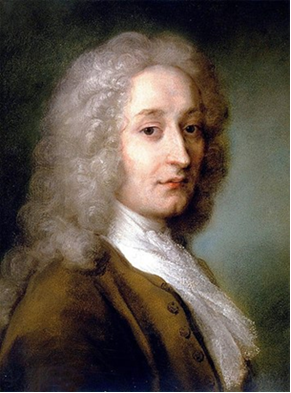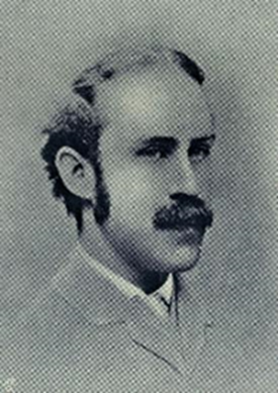by Anna Budziak
“A Prince of Court Painters,” a story about the painter Antoine Watteau, was composed when Pater had already known the taste of fame and the sting of criticism. Although he wished it to be published unsigned, it appeared, in October 1885, in Macmillan’s Magazine, with his name revealed.1) Soon, it was followed by three other narratives: the stories of a melancholic and philosophically inclined youth; a mysterious medieval craftsman; and a fabulously rich, Romantic art collector and amateur archaeologist, the fictional Duke Carl of Rosenmold, journeying, like Johann Winckelmann, from Germany to Italy. They were collected and republished, in 1887, as Imaginary Portraits, a slim volume devoted to a quartet of characters whose dramatic lives stood in startling contrast to the life of their creator, a reclusive don of Brasenose College. Indeed, Pater spent most of his life in the academe. But his university mimicry—him playing possum a long time before it became T. S. Eliot’s game—failed to deceive Oscar Wilde, who admiringly recognized those tales to be the stories of pent-up “passion,” even though he regarded “A Prince of Court Painters” as “a little too fanciful” (164; 163-64).
The Flemish Paters
Imaginary Portraits opens with this “fanciful” piece. The life of Antony Watteau (the anglicized name is used) is reported in the form of a diary comprising forty-one irregular entries while covering over twenty years. The first recount, from September 1701, is followed by the two written in the month of October—when young Antony, a literary version of the historical Antoine born in October 1684— starts his apprenticeship and begins the life of an artist. This temporal coincidence accompanies a correlation of names which is all but coincidental. The character of the diarist was inspired by French-Flemish Marie-Marguerite Pater—daughter of the sculptor Antoine Pater, who served as Watteau’s first mentor and, at the same time, sister of the rococo painter Jean-Baptiste Pater, Watteau’s apprentice and follower.2) Reputedly, when Walter Pater was asked whether this French-Dutch family had been among his ancestors, he confirmed it triply—“I think so, I believe so, I always say so” (qtd. in Symons 330-31)—making Arthur Symons conjecture that it must have been a “kind of family interest” that brought the Pater of British aestheticism to the Flemish artists (331).
Valenciennes and Dresden
Their family name, however, is never mentioned in the story, an omission which A. C. Benson, Pater’s first biographer, attributed to the writer’s “reticent delicacy” (124). Nonetheless, it is through the diary of partly fictionalized Marie-Marguerite Pater (enamoured of the painter, although eventually rejected) that the Victorian Pater conveys his impressions of Watteau and of various rococo paintings. Crucially, Marie’s diary invokes her own portrait exhibited in The Museum of Fine Arts in Valenciennes,3) presenting her as wearing a silken gown, all folds and creases (“A Prince” 25), and holding a twig of laurel, a symbol of the glory of poetry. The ekphrasis is faithful to the original. But, controversially, in “A Prince of Court Painters” the picture is also ascribed to Antony: it is Watteau who begins the painting and leaves it on the easel, for three years, before it is finished on his instruction by Jean-Baptiste. Besides Marie’s portrait, the story invokes Watteau’s painting of her father; Rosalba Carriera’s portrait of Watteau; and several untitled frivolous scenes—depicted on canvas, elegant furniture, and ladies’ fans—which Marie recalls, first longingly, then somewhat resentfully and, eventually, disdainfully, maintaining that Watteau “despise[d]” the beau monde he painted (35).
These unnamed rococo paintings must have caught Pater’s attention when he was visiting the Old Masters Picture Galleryin Dresden. The gallery, Ana Parejo Vadillo states, was a mecca for British art lovers, attracting, among others, Virginia Woolf (326), who had been tutored by Pater’s sister Clara. In fact, it was because of Clara and Hester Pater, living under their aunt’s care in Heidelberg and Dresden, that their brother also travelled to Germany.4) Like Winckelmann before him, and like the fictive Duke Carl, Pater first stayed in the north. Then, in 1865, he travelled south—to Florence, Ravenna, and Pisa—making the journey that inspired his famous, and unexpectedly notorious, Renaissance. Thus, before going to Italy, he had sauntered through the exhibition rooms in Dresden. Their art collections included Watteau’s A Garden Party and Groups of Lovers in a Park, now known as The Feast of Love, displayed next to Jean-Baptiste Pater’s and Nicolas Lancret’s outdoor dancing scenes5); the young Pater could admire the sights of pastoral idleness and sentimental posturing portrayed in eighteenth-century fêtes galantes and fêtes champêtres.
The Swing
One of those fêtes champêtres, The Swing, is mentioned by Marie, who reports unenthusiastically that it is her brother’s “true opus magnum as he hopes” (“A Prince” 30). In the nineteenth century, the picture was exhibited in South Kensington (nowadays the Victoria and Albert Museum); and Walter Pater, fully in accordance with nineteenth-century art history, ascribed it to Jean-Baptiste. In 1908, however, Sir Claude Phillips attributed it to Watteau (345); and today it is recognized as Lancret’s. Yet, even if the picture as we know it is neither Jean-Baptiste’s nor Antony’s, then its theme—the swing—remains central to Watteau’s works, including, as Donald Posner indicates, The Shepherds, The Swinger, and ThePleasures of Summer (77-79). Its symbolism is rich. In the Victorian age, a swaying swing was interpreted as a trope of infidelity, “idleness” and “fickleness” (75-76), which is why to Marie—abandoned after Antony had left Valenciennes and betrayed after he had deepened his friendship with Rosalba—The Swing, an allegory of inconstancy, was too much of a reminder of what had caused her pain. To Pater, however, the image had totally different connotations. In “A Prince of Court Painters,” the motion of a swing corresponds with the flight of a bird lost in the nave of a church, “fluttering round and round” (12) and seeking an exit. Swirling and oscillating, the bird and the swing follow cyclical trajectories of a spiral and a repeated curve. Their movement appears aimless.

Nicolas Lancret. The Swing, c. 1735. Victoria and Albert Museum.
Echoes and Parallels
Such intense, inconclusive movement, in Pater’s universe, suggests the idea of artistic creation as a search for perfection that cannot be satisfied. A similar sense of art’s incompleteness haunted Antoine Watteau, who—as Pater knew from Anne Claude de Caylus’s biography of the painter6)—worked with haste: he painted unconcerned about the proper use of “fast-drying oil paints,” which resulted in the “cracking and alligatoring” patches on the canvas (qtd. in Feinberg and Zuccari 246). Likewise, the semi-fictional Antony, ever dissatisfied with his pictures, hurriedly leaves his projects only half-executed. Marie attributes his haste to “a kind of greed, […] as if things were not to last very long, and one must snatch opportunity” (“A Prince” 38). But the sense of urgency, which Marie decries, is applauded by Pater. To him it was not “greed,” but rather a zest for life. As an essayist and art critic, he saw in Watteau a determination to live for the moment. Such fervency did indeed accord with the ideal he described in his Conclusion to The Renaissance, his succès de scandale opening with a claim that modernity is all about “inconstant modes or fashions” (150) and advising his readers to “burn always with this hard, gemlike flame, to maintain this ecstasy” (152)—the ideal embodied in his vision of the rococo painter.
While judging Watteau, Pater contradicts Marie—or, to use a painterly metaphor, he removes the laurel of poetry and authoritativeness from her hand. He proves her wrong, for Antony idealizes rather than “despises” the world reflected in his paintings (“A Prince” 35). Pater’s Watteau paints with “a marvellous tact of omission” (2), omitting obviousness and commonness while adding “piquancy” (25). But such was also Pater’s way. Even if he thought himself related by blood to Jean-Baptiste, he wrote Antony’s story as a story of himself. Uncannily, several of Benson’s descriptions of the English Pater—based on memories gleaned from family and friends’ reports—can be mistaken for Pater’s representations of Watteau. For instance, to Benson, the pater of English aesthetes is “condemned by temperament to a certain isolation” (188); and, while he is endowed with “low physical vitality,” he is also a perfectionist devoted to his art of writing (201). Its quality is described as “overluxuriousness” (204), a kind of verbal overabundance finding its counterpart in Watteau’s rococo decorativeness. Benson also notes that Pater, an artistically-minded son of a physician, underwent a dramatic transformation from reticence to “a certain recklessness of statement” (187). A similar transformation marks the life of Antony—a shy, artistically gifted mason’s boy who metamorphoses into the painter dictating Paris fashion.
Pierrot, Harlequin, and Columbine
Enormously influential, the historical Antoine—like Pater and similar to Pater’s Antony—had a weak constitution and, like them, he stayed solitary in his genius, “a phenomenon isolated and glorious” (Michel vi). His sense of detachment and ill-health, art historians stress, remain uniquely captured in the figure of Pierrot, the “bumpkin amid sophisticates” (Sund 330). Like the clumsy Clown, Antoine (and Antony) stood alone amidst the fashionable crowd. And, like Pierrot, he was marked for early death. But the death symbolism accrued to Pierrot only in the mid-nineteenth century when his white costume, as Milly Heyd explains, began to signify consumption, “The White Plague” (43). In the eighteenth century, Pierrot played a different role: his body costumed but his face unmasked, he impersonated an uneasy mixture of naturalness and art. This combination is also central to Watteau’s fêtes champêtres, which show fashionable parties flirting in parklands because, to him, nature was only a backdrop for picnics. To Pater, likewise, landscape was only a background for human affairs.7)

Jean-Antoine Watteau, Pierrot, dit autrefois Gilles, c. 1718 – 19. Louvre Museum.
An Autobiography by Proxy
“A Prince of Court Painters,” characteristically, begins with a busy fairground scene: a commedia dell’arte troupe are performing and young Antony is sketching “trite old Harlequin, Clown, and Columbine” (“A Prince” 2). The three foreshadow the story’s most important characters: Jean-Baptiste—devoted, though plodding and materialistic; Antony, the artist; and Marie, the diarist.8) These protagonists, in turn, represent the biographical junctions in the narrative that arose with Pater having taken several steps to disguise his personal interest: allegedly inspired by Jean-Baptiste’s portrait of Marie, he devises the diary of his distant female relative, who recounts Antony’s life story, for which the British author, a connoisseur of painting, used i.a. Caylus’ biography of Antoine Watteau. Going round and round in concentric circles, Pater creates a manifold biographical loop or, to use Anne Marie Candido’s words, indeed, “a kind of visionary biography thrice removed” (151). Yet, the thread of this loop remains autobiographical, for Pater deploys a subterfuge that, later on, would be used, in less clandestine ways, by James Joyce in his “A Portrait of the Artist as a Young Man.” He stresses in Watteau the qualities that resonate with his own unwritten autobiography. It is these parallels—between the views on life and art he expounded in the Conclusion to The Renaissance, precipitating a major scandal, and those he intimated in “A Prince of Court Painters”—that constitute the reason why, in October 1885, increasingly wary of criticism, Pater wished the story of himself in the painter’s disguise to be published unsigned.

Rosalba Carriera. Portrait of Antoine Watteau, 1721. Luigi Bailo Museum.

Walter Pater as a young don at Brasenose: “From a group taken at Brasenose,” no later than 1907.
Works Cited
Benson, A. C. Walter Pater. Macmillan, 1906.
Budziak, Anna. Text, Body and Indeterminacy: Doppelgänger Selves in Pater and Wilde. Cambridge Scholars Publishing, 2008.
Brake, Laurel. Walter Pater. Northcote House Publishers, 1994.
Coates, John. “Aspects of the Intellectual Context of Pater’s ‘Imaginary Portraits.’” The Yearbook of English Studies, vol. 15, 1985, pp. 93-108. https://doi.org/10.2307/3508550.
Candido, Anne Marie. “Biography and the Objective Fallacy: Pater’s Experiment in ‘A Prince of Court Painters’.” Biography, vol. 16, no. 2, 1993, pp. 147-60. JSTOR, https://www.jstor.org/stable/23539578.
Catalogue of the Pictures in the Royal Gallery at Dresden. 8th ed, Dresden: Buchdruckerei der Wilhelm und Bertha v. Baensch Stiftung; Berlin: Julius Bard Verlag für Literatur und Kunst, 1912.
Donoghue, Denis. Walter Pater: Lover of Strange Souls. New York: Alfred A. Knopf, 1995.
Feinberg, Larry J., and Frank Zuccari. “A Rediscovered ‘Fête champêtre’ by Watteau in the Art Institute of Chicago.” The Burlington Magazine, vol. 139, no. 1129, 1997, pp. 236-47. JSTOR, https://www.jstor.org/stable/887430.
Heyd, Milly. Aubrey Beardsley: Symbol, Mask and Self-Irony. Lang, 1986.
Roland-Michel, Marianne. “Watteau and His Generation.” The Burlington Magazine, vol. 110, No. 780, 1968, pp. i-vii. JSTOR, https://www.jstor.org/stable/875577.
Østermark-Johansen, Lene. Introduction. Imaginary Portraits, by Walter Pater, edited by Østermark-Johansen, Modern Humanities Research Association, 2014, 1-66.
Pater, Walter. “A Prince of Court Painters.” 1885. Imaginary Portraits, by Pater. 1887. Macmillan, 1929, pp. 1-48.
Pater, Walter. The Renaissance: Studies in Art and Poetry. 1873. Oxford World’s Classics, Oxford UP, 1998.
Posner, Donald. “The Swinging Women of Watteau and Fragonard.” The Art Bulletin, vol. 64, no. 1, 1982, pp. 75-88. JSTOR, https://www.jstor.org/stable/3050195.
Phillips, Claude. “A Watteau in the Jones Collection.” The Burlington Magazine for Connoisseurs, vol. 13, no. 66, 1908, pp.318+345-347+351. JSTOR, https://www.jstor.org/stable/857625.
Sund, Judy. “Why So Sad? Watteau’s Pierrots.” The Art Bulletin, vol. 98, no. 3, 2016, pp. 321-47. JSTOR, https://www.jstor.org/stable/43947931.
Symons, Arthur. “Walter Pater.” Figures of Several Centuries. 1916. Constable and Company, 1917. The Project Gutenberg E-book [https://www.gutenberg.org/files/21407/21407-h/21407-h.htm, accessed 02 May 2022.]
Vadillo, Ana Parejo. “Cosmopolitan Disturbances: Amy Levy in Dresden.” Forum for Modern Language Studies, vol. 53, no. 3, pp. 325-37, doi: 10.1093/fmls/cqx020.
Wilde, Oscar. “Imaginary Portraits.” Review of Imaginary Portraits, by Walter Pater. 11 June 1887. Walter Pater: The Critical Heritage, edited by R. M. Seiler, Routledge & Kegan Paul, 1980,pp. 162-165.